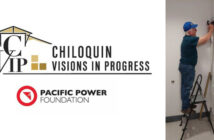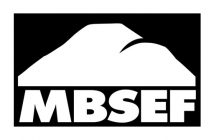Over the last decade, Central Oregon has grown in both population and number of businesses. As Bend and its outlying areas continues to expand, banks and lending institutions have adapted to meet the needs of the community. For the future, local banks and credit unions see a positive trend in our economy that is allowing the institutions to take a more active role in lending as well as all other facets of banking.
Mid-Oregon Credit Union
Bill Anderson, President/CEO
In 1957, eight school employees started Mid-Oregon Credit Union with a need for cooperative financial service for themselves and their co-workers. Today, Mid-Oregon is a $200 million credit union that has six locations and 75 employees providing financial services to over 24,000 members throughout Central Oregon.
Their membership is open to all persons who live, work, worship or attend school in Central Oregon. Mid-Oregon partners with such local organizations as EDCO, OSU Cascades, COCC, Healthy Beginnings, The High Desert Museum, FAN, school districts, Rotary, Chambers of Commerce, Better Together and United Way to strengthen the Central Oregon economy.
Mid-Oregon’s President and CEO, Bill Anderson sees technology, security and banking flexibility as the heart of Central Oregon banking future. Technology will bring personal convenience, while security provides peace of mind. Chip cards, or EMV, incorporate additional security to credit cards, and CardNav applications provide increased control over credit and debit cards though cell phone apps. In addition, new payment systems, such as Apple Pay. integrate your accounts with your cell phone provider.
“There is and will continue to be the need to push for regulatory and legislative support for data breach legislation that holds all parties, including merchants, to high standards for protecting consumer information,” says Anderson.
Credit unions have watched consolidations amongst large banks provide efficiency for the financial institutions, but also limit the choices for consumers. Anderson also sees an improved economy leading to increased lending. Consumers feeling more secure with employment, property values, and market returns will, in turn, invest in newer cars, upgraded homes, and other financial needs, such as education.
OnPoint Community Credit Union
Stephen Wymer, Central Oregon Area Manager
OnPoint Community Credit Union began as the Portland Teachers Credit Union in 1932 when sixteen school teachers looked for a safe place to put their money and offer low-cost loans to members. They currently boast 281,000 members throughout fifteen counties including the cities of Portland, Vancouver, Eugene and Bend.
OnPoint expanded into Deschutes County in 2009 and then to Crook and Jefferson counties in 2011. They take an active role in the communities they serve through their community relations committee. With assets totaling $3.6 billon, they are currently the largest community-owned financial institution in Oregon.
OnPoint and their Central Oregon Area Manager Stephen Wymer are very optimistic for the future of banking on Central Oregon. They continue to invest in the communities they serve, while ensuring the safety and soundness of the investments. The positive signs in the economy have allowed OnPoint to grow in Central Oregon.
“We’re encouraged by the growth we’ve seen in our region and are proud to support that growth by being a strong financial partner,” says Wymer.
OnPoint looks forward to working with consumers by adding technological advances, such as an improved Bill Pay and Apple Pay, and allowing members access to surcharge-free ATMs in all Oregon Rite-Aid locations. They have also strengthened their mortgage lending department. For businesses, OnPoint continues to offer business checking and loans. They are seeing an increase in mobile payments and the usage of online technology to complete banking needs.
SELCO Community Credit Union
Mike Stanley, Central Oregon Area Manager
SELCO Community Credit Union is another member-owned consumer cooperative founded by teachers and other school employees. Established in 1936, SELCO came to Deschutes County in 2000 and currently has 40 local employees and assets in excess of $1.2 billion. SELCO serves 26 Oregon counties and over 100,000 members. They pride themselves on being able to provide the same services as large banks, with personalized attention of a local credit union.
Mike Stanley, SELCO’s Central Oregon Area Manager, sees the advancement of banking technology playing a large part in our local banking future. With each payment system, such as Apple Pay, Google Wallet, and Visa Checkout, Central Oregonians are able to spend less time worrying about banking. The convenience of being able to use online and mobile banking allows local residents to live their life while taking care of their banking needs on the go.
The positive swing in our economy is also affecting mortgages and business loans. Rates and terms are competitive right now and Stanley expects that trend to continue.
“Our real estate market is very active both for consumers buying and selling homes, and businesses looking for commercial space,” says Stanley. “Homes are moving quickly, making it important for buyers to have a mortgage pre-approval in hand before they start actively looking for a home.”
Lastly, SELCO expects Central Oregonians to continue to gravitate towards local financial institutions. They believe credit unions will continue to grow locally because their member-owned, not-for-profit business model resonates with local consumers and businesses.
High Desert Bank
Steve Ferber, CEO
High Desert Bank was established in 2007 as a small bank providing personalized service to their customers. As a true community bank, High Desert Bank employs thirteen at their Bend headquarters. While historically they were focused on commercial lending, they have since expanded their residential housing lending department by adding three new mortgage brokers. High Desert Bank has $28 million in assets.
High Desert Bank’s CEO Steve Ferber has been impressed with Central Oregon’s growth economy of the last two years. He believes that growth will continue over the near future. With a stronger economy will come increased demands on banking in the area. Since the economic downturn, competition amongst banks has changed. Due to regulatory changes, some banks are merging to create larger banks. while others are focusing on staying small and customer-service based, like High Desert Bank.
“We leverage our technology to meet the demands of our clients, including small businesses,” says Ferber.
Updated technology features, such as Mobile Banking and Remote Deposit Capture, have allowed High Desert Bank to compete with larger banks. In anticipation of their customer’s increased technology usage, High Desert Bank has spent an increased amount of money on security, including a complete overhaul of their computer system. Ferber believes every bank’s security budget will have to increase as more technological advancements become available.
US Bank
Coby Horton, Regional President
US Bank is the sixth largest bank in the United States. They employ over 67,000 people total, with 160 in eleven Central Oregon branches. In all, US Bank has over 18.5 million customers with over $403 billion in assets. Headquartered in Minneapolis, Minnesota, US Bank specializes in four areas; consumer and small business banking, wholesale banking and commercial real estate, wealth management and securities services and payment services. Although they have grown into one of the largest banks in the United States, US Bank hasn’t changed their philosophy of focusing on people and relationships since their 1937 establishment.
“We are the only bank in town that can do a $100,000 tag loan and a $100 million commercial health care loan,” says US Bank Regional President Coby Horton.
Customers with positive attitudes have begun to invest in house, car and luxury item upgrades. US bank is seeing more lending across the board. While there are less refinances happening, overall mortgage loans are up. Small business loans and large commercial loans are up, which is a healthy indicator of a positive economy. Horton also points to the fierce competition amongst banks due to industry regulations, and expect that trend to continue.
Horton is impressed with the economy right now, and expects an additional surge later this year. He expects interest rate increases to create a tsunami effect, with people not wanting to miss out on the good rates. The rates will increase, but businesses will invest in themselves, which will result in an uptick in the economy, and then rates will go up again.
Umpqua Bank
Matt Dynice, Vice President, Commercial Relationship Manager
Umpqua Bank got its start out of Canyonville, Oregon’s Masonic Lodge in 1953. What began with one branch, six employees and $75,000 has grown significantly through mergers and acquisitions. They now boast 372 branches in Oregon, Washington, California, Nevada and Idaho with seven in Central Oregon. They employ 30 locally and 2,700 in total. Umpqua Bank has over $11.6 billion in total assets, is top twenty on Fortune Magazine’s Best Companies to Work For list, and Forbes Magazine ranks Umpqua Bank nineteenth on its Best Banks list. The Umpqua Bank Charitable Foundation recently awarded more than $225,000 in grants for non-profit organizations focused on youth development and education and economic opportunity. Their Connect program encourages all associates to volunteer 40 hours per year during work hours for non-profits.
Matt Dynice, vice president, commercial relationship manager for Umpqua Bank sees a bullish economy in Central Oregon and expects it to continue. He has seen employment improve, leading to an improved credit environment. More access to credit has allowed for growth in both residential and commercial banking. Dynice predicts the tech sector, tourism, craft brewing, and hospitality will all contribute to economic growth in the area. Manufacturing and aerospace has shown a positive trend as well.
“Since the downturn in the economy, most locals banks looked to diversify from commercial real estate into CNI (commercial and industrial),” explains Dynice. “It is a very competitive market.”
Dynice believes there will continue to be a shift towards mobile banking and banks to offer a high quality and easy-to-use mobile platform. As consumers are moving towards online banking, banks are investing in security and fraud protection, and away from opening more branches.
Wells Fargo
Colm Boer, District Manager
Established in California in 1852, Wells Fargo is the oldest bank in Central Oregon. The first bank opened here in 1936 with six locations today. Across the country, Wells Fargo has more than 8,700 locations, with 265,000 employees serving 70 million customers. Their $1.7 trillion in assets ranks them by Forbes as the eighth biggest public company in the world. Other accolades include the 29th biggest company by revenue in the United States and 35th most admired company in the world. Closer to home, Wells Fargo has built its reputation on convenience and customer service.
Colm Boer, district manager for Wells Fargo believes the future of banking lies not only in technology, but in maintaining strong relationships with customers. Wells Fargo uses advancements in technology to improve upon the service they offer in personal and business banking. Their secure and protected ATMs provide increased convenience for any banking.
“I want to stress a bank’s success will not be focused only on technology,” says Boer. “Technology will happen for all banks. A good bank will have a a solid relationship with their clients. It’s all about the connection.”
Wells Fargo has seen their mortgage department grow the last two years, and expect that to continue. They have also made helping small businesses succeed a priority, through increased small business lending. They will continue to focus on providing entrepreneurs the tools needed to start and grow businesses. Wells Fargo believes by helping small businesses succeed, communities will thrive through employment and a better economy.
Bank of the Cascades
Terry Zink, President/CEO
Bank of the Cascades was founded in 1977 with their first branch at the corner of Third and Revere Streets in Bend. Today, they have 39 branches in Oregon and Idaho, with ten locations in Central Oregon. In 2014, Bank of the Cascades acquired Home Federal Bank, leading to advanced growth in loans and deposits and increased services, such as mobile banking. They have assets of over $2.3 billion and employ over 500 people. Bank of the Cascades’ fourth quarter 2014 earnings of $5 million doubled their previous quarter and quadrupled fourth quarter 2013. (Note that Terry Zink of Bank of the Cascades was unavailable for this feature story.)
Columbia Bank
Cory J. Allen, Senior Vice President and Commercial Banking Officer
Columbia Bank began as a community bank in Washington in 1993. Today, they have over 150 branches in Washington, Oregon and Idaho, including four in Central Oregon. Columbia Bank employs 25 people locally and has assets in excess of $8.58 billion. Forbes named Columbia Bank as the #1 bank based in Washington, and #17 nationally. Recently, Columbia Bank upgraded their online banking to accommodate all mobile devices in meeting their customers’ needs. (Note that Corey Allen at Columbia Bank was unavailable for this feature story.)





